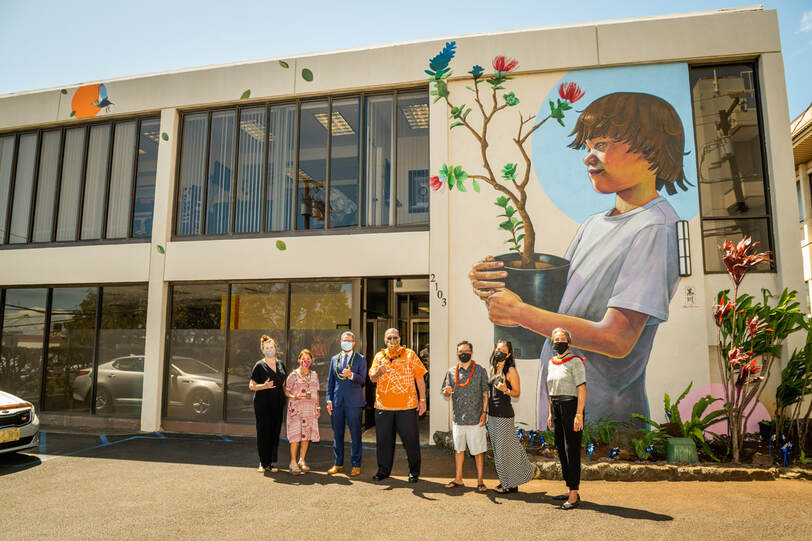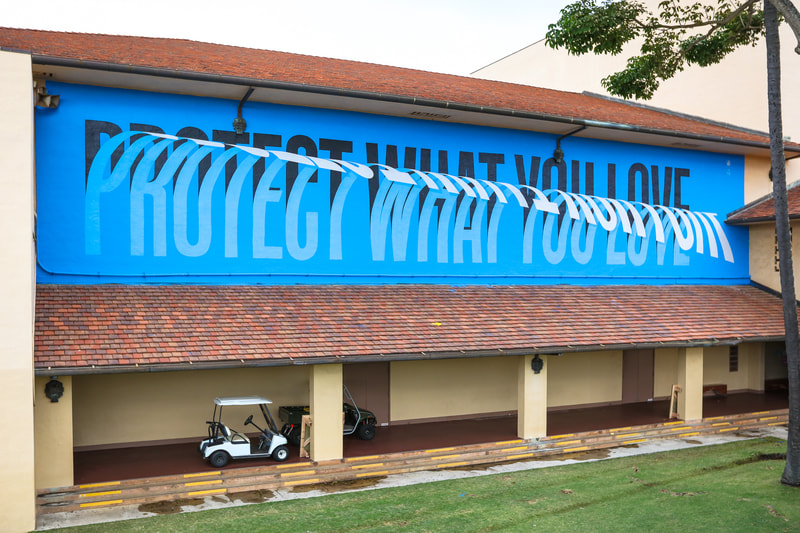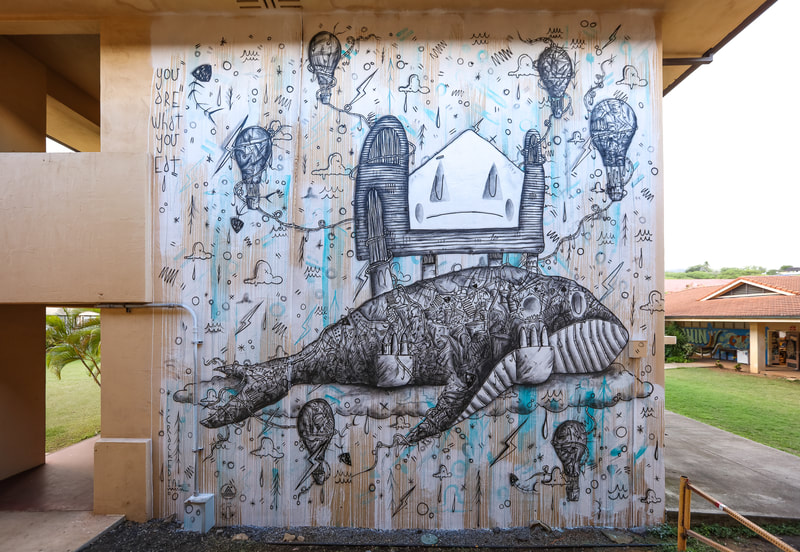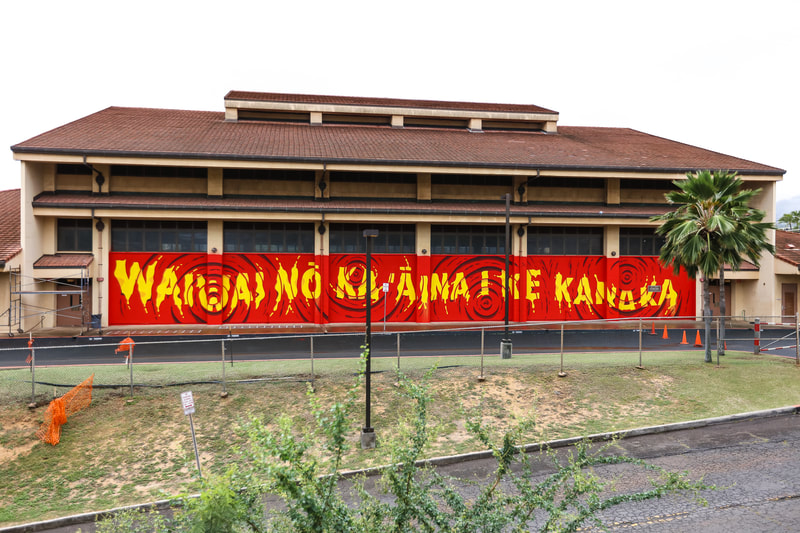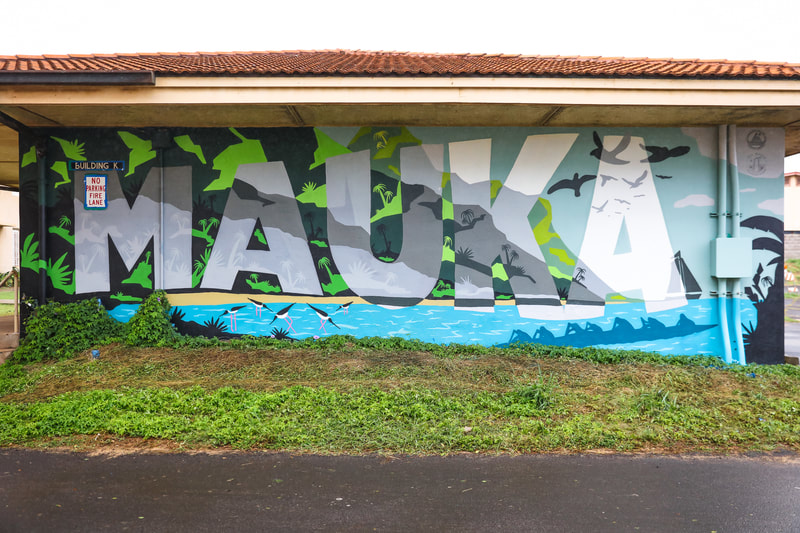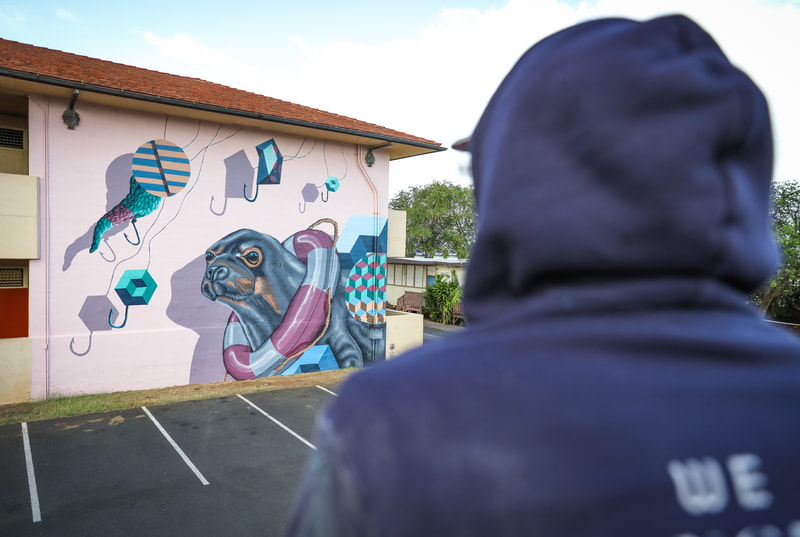ST*BA ARTWORK
Scroll down to view all ST*BA artwork, sorted from most to least recent. Each section includes a link to a unique project page. View a MAP of all artwork.
Wayfinding at Wailuku Garage
|
|
June 2023
6 Murals at the Wailuku Garage Inspired by ʻōlelo noʻeau: He aliʻi ka ʻāina; he kauwā ke kanaka (the land is a chief; man is its servant) In June 2023, artists Matthew Kawika Ortiz and Roxanne Ortiz — who paint under the name Wooden Wave, created 6 large-scale artworks within the Wailuku Garage to function as directional signage; offering a wayfinding element that draws people to entry and exit points and also helps distinguish the varying floor levels of the space. Working in collaboration with design teams and community members, they spent 3 months participating in community engagement activities that resulted in a design of distinct landscape elements, a color palette, and animal species unique to each floor. Through additional huaka’i and a free talk-story event at the Wailuku Public Library, they developed and interpreted the connections between their artwork design and the Wailuku ahupuaʻa, ultimately rooting the collection in ‘Ōlelo No‘eau: He aliʻi ka ʻāina; he kauwā ke kanaka (the land is a chief; man is its servant). |
Anthony Pfluke at Kipuka Square
|
|
June 2023
Pop-Up Performance Inspired by ʻōlelo noʻeau: (TBD) In June 2023, Nā Hōkū Hanohano finalist Anthony Pfluke performed a public pop-up performance featuring original songs inspired by Kahoʻolawe and Wailuku, Maui. Following a 4-day volunteer access with the Kahoʻolawe Island Reserve Commission, Anthony worked closely with community members with special ties to this place to write Kū Kīaʻi Kanaloa. Through community consultations with Wailuku sources, an artist huaka’i of the Waihe’e Coastal Dunes and Wetlands Refuge with Hawaiʻi Land Trust, and study of Mary Kawena Pūkuʻi’s ‘Ōlelo No‘eau: Hawaiian Proverbs and Poetical Sayings in partnership with Sissy Lake-Farm, Pfluke composed E Ola ʻĪao. The one-time-only pop-up performance was held at Kīpuka Square in Wailuku, and additionally featured music celebrating the distinctive sense of place, history and culture of these special Maui places — the majority of which were performed in ʻōlelo Hawaiʻi. |
Tanama Colibri at Kalana O Maui Building
|
|
May 2023
Pop-Up Performance Inspired by ʻōlelo noʻeau: He poʻo ulu ko na mea kanu (Plants have heads that grow again) In May 2023, Wailuku-based singer, songwriter, author and poet Tanama Colibri performed a public pop-up performance featuring original songs inspired by both Kahoʻolawe and Wailuku at the Kalana O Maui Building Front Lawn. Colibri’s music and lyrics were developed through a 4-day volunteer access with the Kahoʻolawe Island Reserve Commission, recorded consultations with community members, and an interactive workshop with the sixth grade class of ʻĪao Intermediate School. The event opened with a pule by Uncle Bill Garcia of Hālau Nā Hanona Kūlike O Piʻilani and included collaborative performances with 15 sixth-grade ʻĪao students and three teachers from King Kekaulike High School. |
During this time block, we developed public art projects with Lānaʻi City, Kaho’olawe and Kahului. Visit Maui Public Art Corps to learn more!
Wailuku Ho'okele at 33 Market Street
|
|
June - August 2022
Edwin Ushiro Mural in three sections at 33 Market Street Inspired by ʻōlelo noʻeau: Kala kahiko I au wale ai ka lā (The sun has gone down long since Inspired by an audio recorded talk-story between Cultural Historian & Resource Specialist Kepā Maly and Lopaka White of the Kahoʻolawe Island Reserve Commission, Maui-born and Los Angeles-based artist Edwin Ushiro designed this mural from June — August, 2022. Located at 33 Market Street in Wailuku, the piece depicts water within the building’s recessed window shapes in an attempt to place the viewer on the open sea. Each of three windows contain a constellation: 1) Iwikuamoʻo bone back lizard, Hōkūleʻa shines in orange-red; 2) Ka Lupe o Kawelo, Lupe or sting ray; and 3) Ka Makau Nui o Māui, Māui’s Fish Hook with Māui. |
Of the Land at 27 N. Market Street/ First Hawaiian Bank
|
|
June - August 2022
Sachelle Dae Three super-sized oil paintings installed at 27 N. Market St./ First Hawaiian Bank Inspired by ʻōlelo noʻeau: #2829: Ua mau ke ea o ka `āina i ka pono (the life of the land is preserved in righteousness) This series of three oil paintings were developed from two Talk-Story recordings: One between Anuhea Yagi, Student of Hawaiian Life Ways and Roselle Bailey, Kumu Hula, KaʻImi Naʻauao O Hawaii Nei Institute, and another between Kalapana Kollars, Hawaiian Cultural Programs Director, Lahaina Restoration Foundation and Wallette Pellegrino, Host of ”Preserving Our Recollections” Oral History TV Program. The artist's paintings were scanned, super-sized and temporarily exhibited facing Market Street from First Hawaiian Bank Wailuku Branch (27 North Market Street), and were complemented with a written work by poet Anuhea Yagi. |
Wailuku Wings at Imua Discovery Garden
|
|
February - June 2022
Bobby Zokaites Sculpture located at 2471 Main St, Wailuku/ Imua Discovery Garden Inspired by ʻōlelo noʻeau: I mohala no ka lehua i ke ke'eke'ehi 'ia e ka ua. (Lehua blossoms unfold because the rains tread upon them. It is the rain that brings forth the lehua blossoms. So do gentle words bring forth much that is desired). This sculpture was developed over six months through community consultations with Hawaiʻi Land Trust Chief Conservation Officer Scott Fisher, Ph.D; Kim Thayer of Mauna Kahālāwai; the Bailey House Museum's Kimo Guequierre; master lauhala weaver and Kahoʻolawe Island Reserve Commission Executive Director Mike Nahoʻopiʻi; Bishop Museum Entomology Collections Manager Jeremy Frank, Ph.D.; and ST*BA + Imua team members -- both virtually from the artist's Tempe, AZ studio as well as in Wailuku during a February site visit. |
Art Inspired by Wailuku Storytellers: Ace & Son Moving Picture Co.
|
|
April 2022
Ace & Son Moving Picture Company artists Anne Beal, Alex Fyock, Natalie Greene, Alexandra Reshanov, Winnie Wu, Taisiya Zaretskaya, directed by Richard O'Connor A collection of 6 animated interpretations from our Talk Story series Inspired by ʻōlelo noʻeau #327: E lauhoe mai na waʻa; i ke kā, i ka hoe; i ka hoe, i ke kā; pae aku i ka `āina. (Everybody paddle the canoes together; bail and paddle, paddle and bail, and the shore is reached. Pitch in with a will, everybody, and the work is quickly done.) Imagine a room crowded with voices of discovery, contemplation, concern, hope,” reads the Artist Statement from Richard O’Connor’s final project synopsis, “The sounds envelop, invite you to join. Each point, a vibrating locus of community. Each person is a star in the ever-expanding constellation. |
Art Inspired by Wailuku Storytellers: Cory Taum + Adaptations
|
|
March 2022
Return to the Source by Cory Kamehanaokalā Holt Taum, inspired by ʻōlelo noʻeau: Hoʻi ka ʻoʻopu ʻai lehua i ka māpunapuna. The lehua-eating ʻoʻopu has gone back to the spring. Said of one who has gone back to the source. The Bits Left Behind by Adaptations Dance Theater, inspired by ʻōlelo noʻeau: I ka nānā no a ʻike (By observing, one learns). Collaborative interpretations of a recorded Talk Story between Clifford Naeʻole, Cultural Advisor at The Ritz-Carlton Kapalua and Hōkūao Pellegrino, Sustainability & ʻĀina-Based Learning Designer & Facilitator of Kamehameha Schools Maui, Taum's mural was celebrated with a public unveiling at 2121 Main Street immediately followed by a one-night-only dance performance by Adaptations Dance Theater. |
StoryCorps DIY: Talk Story
|
|
July – October, 2021
Gordean Bailey | Roselle Bailey | Skippy Hau | Hōkūlani Holt | Kalapana Kollars | Sissy Lake-Farm | Kepā Maly | Clifford Naeole | Hōkūao Pellegrino | Wallette Pellegrino | Kim Thayer | Dean Tokishi | Lopaka White | Anuhea Yagi A collection of cross-generational conversations designed to capture an authentic moment of connection Participants of Leilehua Yuen's "The Value of Storytelling" project were each paired with kumu to engage in an audio-recorded conversation with the goal of capturing an authentic moment of connection. Edited 3-minute segments became the basis for our fall 2021 ST*BA call-to-artists process, wherein applicants based 2022 public art proposals off of a story of their choosing. The collection will become part of the Maui Historical Society archive and is available at our StoryCorps page archive. Ball State University's Center for Emerging Media Design and Development is evaluating this pilot to help create an oral histories archive. |
Light Painting at 62N & 7N Market Street
|
|
September/ October 2021 Lori Hepner Light painted video projection, wall mural decals, and mobile app Inspired by ʻōlelo noʻeau: E ala! E alu! E kuilima! (Up! Together! Join hands!) Lori worked with ʻĪao Intermediate School and Hālau Makana Aloha O Ka Lauaʻe during an educational Light Painting Wailuku residency that began on September 30, 2021. A video projection, two wall mural decals, and mobile app resulted from a series of educational workshops, which will remain in the community long after the art-making experience has taken place. Using LEDs for individuals to light paint together and to create silhouette portraits of one another symbolically joining hands, local musicians and performers provided the inspiration for each resulting artwork that Lori captured with her real‑time, light painting system that is used to draw with light using the body. |
Wailuku Dance Crawl along Market Street
|
|
August + November 2021
Adaptations Dance Theater (ADT) A collection of 3-minute phrases at 5 distinct Wailuku Town locations Inspired by ʻōlelo noʻeau: E kūlia i ka nu‘u (strive to reach the summit) Socially distanced, pre-registered participants were invited to join contemporary dance company Adaptations Dance Theater as they traveled throughout 5 distinct Wailuku Town outdoor locations - much in the spirit of a treasure hunt or pub crawl - offering performances to encourage (re)engagement with these spaces and create the opportunity to make new memories and shared experiences for our community and audience members. Due to Maui’s voluntary 21-day deferment of non-essential activities, the August event was rescheduled to November. Photos: Sean Hower |
The Value of Storytelling
|
|
April - July 2021
Leilehua Yuen Virtual Workshop Intensive Following two years of planning and research, artist Leilehua Yuen of Hilo, HI, presented a series of virtual Edutainment workshops between April - June, with a final in-person event in July 2021. Joined by haumāna from Maui Academy of Performing Arts, Kamehameha Schools Maui, Mauna Kahālāwai, Hale Hōʻikeʻike at the Bailey House Museum/ Maui Historical Society, Kahoʻolawe Island Reserve Commission and Lahaina Restoration Foundation, the group explored the purposes of storytelling, the value of the search for knowledge, and encoding that knowledge in moʻolelo. |
Mana Wahine at the Wailuku Municipal Parking Lot
|
|
June 2021
Bailey Onaga, Courtney Chargin, Amanda Joy Bowers, Alex Underwood A collection of three murals that will serve as the temporary construction wall surrounding the Wailuku Municipal Parking Lot Inspired by ʻōlelo noʻeau:
Visit the project page at smalltownbig.org/manawahine Photos: Sean Hower |
Makai to Mauka at the Wells Park Temporary Parking Lot
|
|
April 2021
Jaclynn Sabado-Eitel Put-In-Cup installation art on Wells Street, Wailuku Inspired by ʻōlelo noʻeau: Ka i'a mili i ka poho o ka lima (the fish fondled by the palm of the hand) Visit the project page at smalltownbig.org/sabadoeitel Photos: Sean Hower |
Hoʻomau at the Victim Witness Building/
Maui County Children’s Peace Center
|
March 15 - April 1, 2021
Kirk & Karla Kurokawa Mural located at 2103 Wells Street, Wailuku Inspired by ʻōlelo noʻeau: He lei poina 'ole ke keiki (A lei never forgotten is the beloved child) Inspired by 300 sketches created in February 2020 by the sixth grade class of Iao Intermediate School and by conversations with those working to develop the Maui County Children’s Peace Center, Kirk's piece was unveiled with a blessing led by Uncle Bill Garcia in acknowledgement of April's Child Abuse Prevention Month. |
Legacy at First Hawaiian Bank Wailuku Branch
|
|
February - March 2021
Avi Molinas Temporary Installation of supersized oil painting replicas at 27 N Market St, Wailuku (First Hawaiian Bank Wailuku Branch) Molinas' original intent was to install his paintings of Wailuku icons Hōkūlani Holt, Judge Noa (Auwae) Kepoikai and Rose (Daniels) Kepoikai at Hale Hōʻikeʻike at the Bailey House Museum, where visitors and community members could spend time with the paintings and "learn more about the everyday lives of the people who are indigenous to this land." However, due to the COVID-19 pandemic, the team opted to supersize the paintings, find a local partner to display them towards the streets of Wailuku, and create a short film to get the momentum flowing for conversation and continual exchange. Please CLICK HERE to share your own mana'o on legacy. |
ʻAlalā Renaissance at the Main Street Promenade
|
|
November 2020
Michael Takemoto Temporary Installation at the Main Street Promenade, Wailuku Inspired by ʻōlelo noʻeau: Hoʻolaukanaka i ka leo o nā manu (the voices of birds give the place a feeling of being inhabited) Initially planned for March 2020, Takemoto’s pre-COVID-19 “A Murder of ʻAlalā" installation was to be an open invitation to the community to create black charcoal silhouettes throughout the town from a collection of ʻalalā stencils created by the artist. As the artwork naturally faded with the elements, his aim was to bring awareness to the plight of the ʻalalā, or endangered Hawaiian crow, as their numbers have been decimated through the loss of their natural habitation and the incursion of non-native species. Reimagined for a post-COVID community, the artist’s ʻAlalā Renaissance brought pre-registered, socially-distanced artists together to insert hundreds of brightly colored chalk ʻalalā silhouettes throughout town in an expression of hope, rebirth and healing. |
Ma kāhi o ka hana he ola malaila (where work is, there is life)
at 2050 Main Street, Wailuku
|
|
October 2020
Eric Okdeh Mural located at the Main Street Promenade/ 2050 Main Street in Wailuku Inspired by ʻōlelo noʻeau: Ma kāhi o ka hana he ola malaila (where work is, there is life) Created in collaboration with the Wailuku community, composition elements include Wailuku arts memories and influences, displayed on a billowing purple kimono being created by a teacher and her student from the 1911 Kanda Home in Wailuku, which was a boarding school for "unfortunate Japanese girls." Images include the St. Anthony Boys' School Band of the 1950s with conductor Walter Garcia; Kumu Hula Emma Sharpe; Hawaiian Music Icon Willie K; the Philippine tinikling dance - done between bayuhan, wooden pestles used to pound husks off of rice grain; Maui Chamber Orchestra; Maui Academy of Performing Arts and more, with art forms based in Japanese, Portuguese, Filipino and Hawaiian cultures. Together, the piece speaks to Wailuku as the hub of migration and multiculturalism that has given us so many chapters of artistic flavor since memory and available archives serve. |
Birds of a Feather at MAPA Main Studios, Wailuku
|
|
February 2020
Maui Academy of Performing Arts (MAPA) A Maui Musical in Wailuku Inspired by ʻōlelo noʻeau: E aloha kekahi i kekahi (love one another) An original musical set on Maui written by Kathy Collins with music by Marti Kluth, the show is performed by MAPA's troupe of professional performers: Kathy Collins, Logan Heller, Carlyn Leal, and Kiegan Otterson with live music performed by Gilbert Emata. The story follows Moa (the Hawaiian chicken), Pīkake (the peacock), and Manu’aipilau (the mynah) who struggle to accept and appreciate their differences. To their great surprise, they learn that they are actually more alike than not, and they ultimately discover that their community is stronger because of their diversity. |
Chinese Take Out: Super Size at the County Building
|
|
January 2020
Sean Baba Installation unveiled at 200 S. High Street in Wailuku Inspired by ʻōlelo noʻeau: O ke aloha ke kuleana o kahi malihini (love is the host in strange lands) “There are many aspects and cultures that make Maui, Local,” shares Baba, “A symbolic Icon of Hawaii and Wailuku is the Chinese to go container. It symbolizes memories and the mixture of cultures that have mixed and grown to become Hawaiʻi. When I created this, it was received beyond what it represented to me, and the diversity of who gravitated to it was overwhelming. I have been told that Wailuku needs an artwork that symbolizes art, culture and food and this to me has represented this to everyone who has seen it.” |
Hīnaʻi at Kīpuka Square
|
|
December 2019
Jessica Bodner Sculpture currently at 2375 Main St., Wailuku (Bailey House Museum) Inspired by ʻōlelo noʻeau: ‘A‘ohe hana nui ke alu ‘ia (No task is too big when done together by all) This 6-foot reclaimed steel sculpture by Maui-based Jessica Bodner was originally installed at Kīpuka Square, and has since been relocated to the Bailey House Museum. In a unique collaboration with Boy Scout Troop 40 and local artist Amanda Joy Bowers, a Little Free Library was simultaneously erected at the site with the proverb painted on it. Through site visits with the troop, at her studio and a public unveiling and blessing ceremony, Bodner engaged hundreds of Wailuku residents and visitors. Together, these projects illustrate the proverb “Give a man a fish and you feed him for a day; teach a man to fish and you feed him for a lifetime.” |
Pō Meke‘au at the Omura Building & Wells Park
|
|
November 2019
EHA (A group of 4 artists: Kirk Kurokawa, Elmer Bio, Amanda Bowers and Noble Richardson) Mural at 2049 Wells St., Wailuku Inspired by ʻōlelo noʻeau: ‘A‘ohe hana nui ke alu ‘ia (No task is too big when done together by all) "Fingerprints of four valleys opening light tunnels that pierce the curiosity of our spirit as daylight sets. Four rivers that run deep, carve sharp valleys, flow cleanly and silently greet our ocean. They flow in unique directions tethered by Pu‘u Kukui, the highest peak, last to bid light a farewell. Rippling down wave shaped edges of our mauna are pockets of silvery green leaves. The kukui; a gift from the ‘aina that serves as flavor, varnish, fishing techniques, medicine, la‘au lap‘au, subject of mo‘olelo and fuel to sustain fire..." LEARN MORE. |
Eli at MAPA Main Studios
|
|
October - November 2019
Emmanuel Jarus Mural at 2027 Main Street, Wailuku Inspired by ʻōlelo noʻeau: ‘Ike aku, ‘ike mai. Kōkua aku, kōkua mai. Pēlā ka nohona ‘ohana (Watch, observe. Help others and accept help. That is the family way) "In freshwater and salt, water as the heartbeat of life’s existence resonated. Having had the opportunity to be immersed within the river + ocean waters guided by Wailuku residents, and, taking in where the stream meets the sea at the Waiheʻe Coastal Dunes and Wetlands Refuge, these experiences observing life became the inspiration for the mural." Photos: Bryan Berkowitz |
lost & found at Kīpuka Square
|
|
September 2019
Andy Behrle Ephemeral light work installation/ 1-night only at 68 N. Market St., Wailuku Inspired by ʻōlelo noʻeau: Ma ka hana ka ‘ike (in working, one learns) Following four months of project development, artist Andy Behrle worked with dozens of community members to research, re-imagine and refine a light installation depicting a stained glass window from St. Anthony Church before it was lost to a devastating fire in 1977. Through hours of footage collected at different points of the Wailuku River, panes of glass were replaced with visions of water. The piece was on view for one night only, projected onto ʻĪao Theater during the September 2019 Wailuku First Friday event |
Resemble The 'Alalā at 2020 Main Street
|
|
February 2019
EHA (A group of 4 artists: Noble Richardson, Elmer Bio, Amanda Joy Bowers, Kirk Kurokawa), Pangeaseed Foundation Mural at 2020 Main Street in Wailuku “We are a group of 4 artists with one coherent message. This mural not only represents our amazing ahupua'a it represents the voices within it. Our message is meant to be heard and carried far beyond our shore to share our knowledge with the world, and through @pangeaseed Foundation we can synthesize and reconnect as a single consciousness of caretaking for life. It is a message of artivism with a mission of planting seeds to strengthen our ecosystem.” PHOTOS: Tre' Packard |
Untitled at Uptown Chevron
|
|
February 2019
Gregg Kaplan, Pangeaseed Foundation Mural at 2085 Main Street in Wailuku “My piece is inspired by the concept of Mauka to Makai and the belief that all things in nature are connected. The mural showcases different prints, patterns, colors and textures that I have seen along the journey that Maui’s streams take through the valleys towards the shoreline and into the ocean. I entered into this project with no final outcome in mind and enjoyed working through the weather and rain, meeting new friends local and around the world and bringing the different elements together spontaneously.” PHOTOS: Tre' Packard |
High Tides / Low Tides at Market & Vineyard
|
|
February 2019
Kaiʻili Kaulukukui, Pangeaseed Foundation Mural at 24 N. Market St., Wailuku “The oceanic composition in High Tides/ Low Tides is meant to represent the change in tidal movements throughout the year. The moon phase is stuck on full to indicate the maximum effect of the process, and to strengthen the idea of the power caused by a full moon. The large red sun is layered over the ocean as a reminder that a large chunk of our trash is from Japan and other countries far across the sea. The subdued color palette is meant to represent the lost luster of plastics as they are heated in the sun and broken down in to micro plastics. The honu who is stuck in the lines and plastic represents us, people stuck in their ways and trapped by routine. The swimmer reaching to pull off the debris is a keiki, the literal representation of our future, and the idea of positive change that can be obtained.” PHOTOS: Tre' Packard |
Navigating Our Future at 1774 Lower Main
|
|
February 2019
TECHS, Pangeaseed Foundation Mural at 1774 Lower Main St., Wailuku "My mural features Maui’s very own navigator Kalā and her son Te Kauri. Kalā is helping to ensure the future of wayfinding and traditional ocean voyaging are maintained for the next generation. For navigators, stars play an important role in wayfinding. Stories and tales were specifically created to ensure that the way to find a certain place was remembered. It was also told in such a way a child could remember the tale thus, allowing us indigenous Maori and guardians of both land and sea to hand our sacred knowledge down through the generations.” PHOTOS: Tre' Packard |
Kaulana Nā Wai ʻEhā at Uptown Chevron
|
|
February 2019
Cory Kamehanaokalā Taum, Pangeaseed Foundation Mural at 2085 Main Street in Wailuku “This piece is my tribute to the four famous streams of west Maui and the importance of the Ahupuaʻa system in both traditional times and even more so, today. The textures of the mountain valley and the ocean hope to share how the original people of this land were very aware of the importance of the patterns in nature that surrounded us; from the visual patterns found on many life forms around us, to the cycles in the earth and sky. The bold panel of pattern the runs through the middle of the composition represents each of these stream systems, Waikapū , Wailuku, Waiehu and Waiheʻe, running from the watershed all the way down the ocean. The center image is a "Hue wai", a traditional Hawaiian water gourd, an item that was once an very important part of life when the resource of water was understood as the one of greatest riches in life." PHOTOS: Tre' Packard |
Legacy at South Church & Wells
|
|
February 2019
Dulk, Pangeaseed Foundation Mural at 2085 State Highway 32 (parking lot at South Church & Wells Street), Wailuku “Last year (2018) I had the chance to visit the Hawai'i archipelago for the first time and I was very lucky to feel incredible sensations being very close to a humpback whale and her calf. Maui is one of the best places to see the humpback whales in the world and we were there while breeding season was happening so the opportunity was the best to create it. Working in this piece has been really emotional for me. Legacy represents the eternal travel of a humpback mum and her calf traveling to a better place. Our seas are being subjected to dramatic circumstances every day and their inhabitants flee without a way to a better place. They camouflage themselves between ecosystems trying to escape from an announced end.” PHOTOS: Tre' Packard |
Native Protector at 1975 E. Vineyard
|
|
February 2019
Joey Rose & Alexandra Underwood, Pangeaseed Foundation Mural at 1975 E Vineyard St., Wailuku “Ocean acidification, an issue largely unknown, is a serious and growing threat to our oceans. But there is some hope: although not a permanent solution, studies show that replanting certain species of native coral help reduce the effects of ocean acidification. In our mural, the native coral in the center of the composition stands tall in protection of the rest of the reef. We chose to highlight the immense power of this native coral. The large central coral is strong and solid, while the other sea life is becoming translucent as they come in contact with the large dark shapes, symbolizing the effects of acidification.” PHOTOS: Tre' Packard |
Celestial Guidance at 1132 Lower Main St.
|
|
February 2019
Mary Iverson, Pangeaseed Foundation Mural at 1132 Lower Main St., Wailuku “My mural is meant to inspire us to find a balance between technology and nature. The design portrays the observatory atop Haleakalā next to the Polynesian navigation compass. Both entities help us look to the stars and ponder our position in the universe, but each represents a very different perspective; modern tools on one side, ancient wisdom on the other. We have made so many technological advances but we’ve lost our connection to nature, resulting in a world in peril..." PHOTOS: Tre' Packard |
Nāmakaokahaʻi at Market & Vineyard
|
|
February 2019
Lauren Brevner, Pangeaseed Foundation Mural at 98b N Market St, Wailuku “Inspired by Hawaiian mythology, I choose to represent the topic of overfishing with my interpretation of the sea goddess Nāmakaokahaʻi. Her waters are seen as empty and lacking life, this visual combined with a limited palette emphasizes a loss of color and vibrancy that our oceans once had. Highlighting a netted parrotfish (a species that is integral to the protection of coral reef health) which are severely overfished in Hawaii is another reminder of the many ways overfishing has an impact on our oceans. As an ARTivist it was very important to me to create a piece that was visually engaging, easy to understand and positive while still carrying a clear message.” PHOTOS: Tre' Packard |
Mauka to Makai at 1830 Mill St.
|
|
February 2019
Matthew and Roxanne Ortiz aka Wooden Wave, Pangeaseed Foundation Mural at 1830 Mill St, Wailuku “This mural was painted in collaboration with @coral_org in an effort illustrate the importance of caring for the upstream or “Mauka” regions in order to keep near shore reefs clean and clear of harmful run-off. The tree house in the foreground serves a research outpost and native plant nursery for conservationists who are revegetating eroding gulches. The phrase written on the right side of the mural translates to “Mountain to the Sea” and highlights the idea that the well being of the ocean is intrinsically tied to the health of our upland ecosystems. Protecting our seas is laborious but satisfying work..." PHOTOS: Tre' Packard |
While the projects above were not installed in Wailuku Town, they were an incredible part of Pangeaseed Foundation's February 2019 project. Congratulations to the artists: Ben Johnston (“Protect What You Love”), @crackedink (“You Are What You Eat”), Gavin Murai (“Prosperity”), Getso (“Towards Hope”), and Jerry Rugg (“Hawaiian Monk Seal”) LOCATION: Baldwin High School, Wailuku, HI
